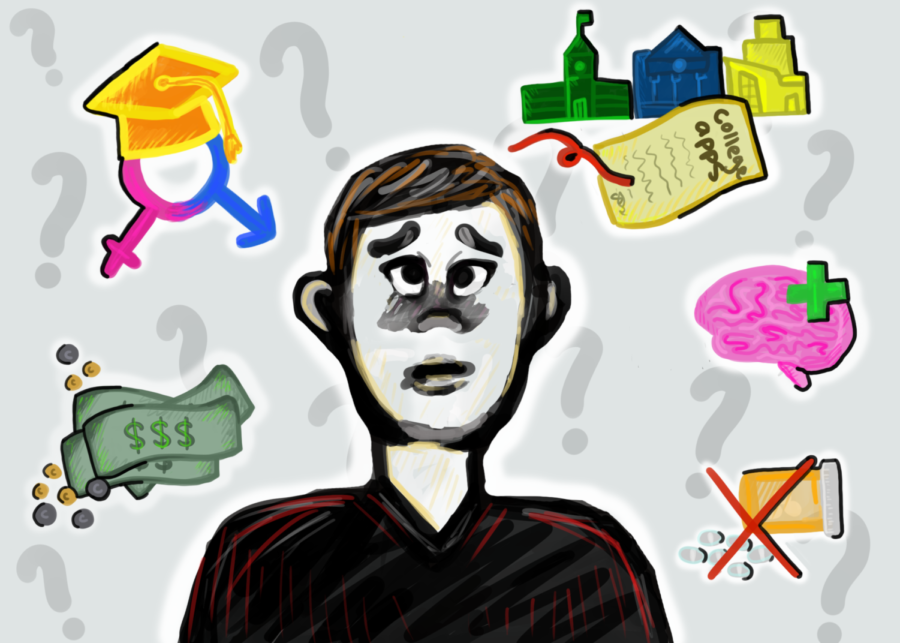What we need to learn in high school
photo by Alexis Madlang
High school should be preparing students for the next step in their lives, but some feel they are missing out on learning important information. A solution to this problem is making a required course that combines all of the confusing curriculum into one class.
Acing AP exams, speaking and writing in other languages, constructing beautiful essays, painting and sculpting masterpieces – during high school, students learn a multitude of skills. However, due to the increasingly competitive nature of college and the workforce, high school curriculum has focused more and more on strong academics. Although strong academics are crucial, students are not taught enough skills necessary for the real world. If high school is about preparing students for their next step in life, why do students still feel unprepared?
Without the guidance and help from family members, most students would lack important information in subjects like college admissions, sex education or home ownership. A solution to reduce the number of students that lack confidence in these areas: a graduation-required course covering topics like this in-depth.
In 2003, Florida Statutes required completion of a minimum of 24 academic credits in grades 9-12 to earn a standard high school diploma, including one-half credit in Life Management Skills. This course was broken down into sections covering health in the first semester, then general skills such as financial literacy and home care in the second semester.
Between 2006 and 2007, the Seminole County School Board voted to remove the course, both as a graduation requirement and as a class itself. With this, some of these topics were integrated into other courses such as the sex education section covered in Biology. Although students still get exposure to these topics, they are very briefly covered and seemingly forgotten.
The Drug Abuse Resistance Education program is taught in fifth grade, and Life Skills is taught in sixth or seventh grade. The DARE elementary curriculum is developmentally appropriate and based on the powerful Social Emotional Learning approach. This curriculum teaches the foundational skills that youth need to be safe, healthy and responsible in leading drug-free lives. Participating in DARE is great, but covering these topics while students are so young is not enough. Especially since in high school, students are much more open to learning life skills like managing a household and finances. The best approach to solve this would be participating in DARE during middle school, followed by a life skills class in high school. Teaching students an up-to-date curriculum similar to DARE would be the best for students today.
Sex education is an important subject that students skim the surface or completely miss out on today. We’d like to believe that all parents sit down and talk to their children about “the birds and the bees,” but too many teens are uniformed or learn about sex from what they hear from peers. Less than half of high schools and only a fifth of middle schools are teaching the sexual health topics that the CDC considers “essential” for healthy young people. State legislation needs to change to keep their students safe, protected and aware, especially at a time when this is most relevant.
Another reason that a high school Life Skills class would make sense is to deal with the mental health crisis secondary schools are facing today. The State Board of Education passed a rule requiring every Florida public school to provide students in grade 6-12 at least five hours of mental health instruction each year. Florida counties follow through with this by walking students through required Nearpods during their regular classes. The current instruction is inconsistent and often ineffective, but if presented in its own course, the material would be more meaningful. Whether through Nearpods or through teacher-developed instruction, students would benefit from a class that taught topics such as self-care, identification of abusive relationships, growth mindset and self-improvement and symptoms of depression or anxiety.
Of course, a Life Skills course could still help with one of the county’s ultimate goals – successfully transitioning high school students to college. But in our current system, topics like college admissions and financial planning are a mystery. Most do not know the difference between an Early Action and Early Decision application. Currently, among high school graduates ages 16-24, college enrollment rates for men and women were 59.3% and 66.2%, respectively. With a class making the process less daunting, application rates would increase.
Each year, students are online more and face-to-face less, they are struggling to manage their schedules, and they are dealing with more mental health issues than ever before. General life skills are more needed than ever. Instead of leaving students insecure about their futures outside of education, the county should provide a course that will fully prepare them.
Your donation will support the student journalists of Hagerty High School. Your contribution helps us publish six issues of the BluePrint and cover our annual website hosting costs. Thank you so much!


